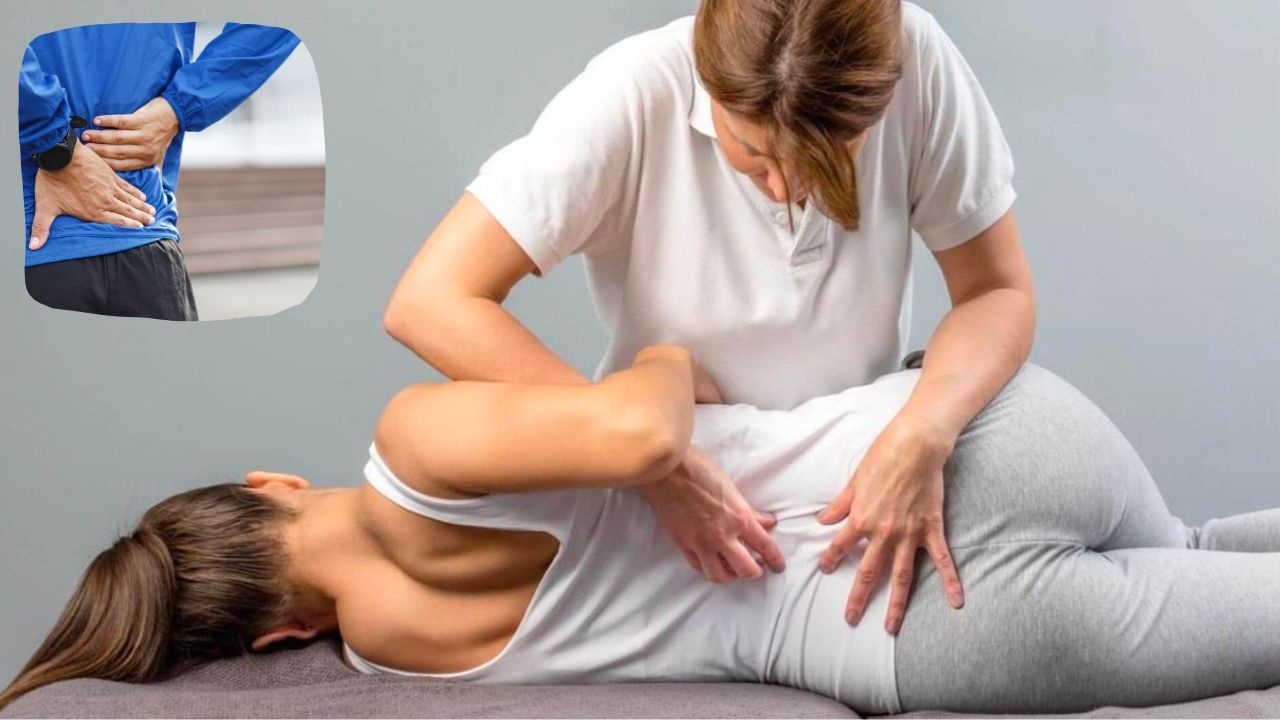How Can I Realign My Tailbone At Home?
How Can I Realign My Tailbone At Home: Your tailbone, a small yet significant part of your spine, plays a vital role in your comfort and mobility. Discover how to care for and support your coccyx at home to keep it in tip-top shape, all while ensuring you sit, stand, and move without discomfort.

Dealing with tailbone misalignment can be uncomfortable, but several home-based strategies may help realign the tailbone and alleviate associated discomfort. It's important to note that severe or persistent pain should be addressed with professional medical advice.
Understanding Tailbone Misalignment
Before attempting any realignment, it's crucial to understand what might cause tailbone misalignment. Trauma, prolonged sitting, or childbirth can contribute to this issue.
How Can You Adjust Your Tailbone Yourself?
Adjusting your tailbone yourself can be a bit like trying to perform your dental work – not recommended unless you're a professional. Your tailbone, or coccyx, is a delicate area that can be sensitive and prone to injury. Attempting self-adjustment without proper knowledge or guidance can potentially lead to more harm than good.
However, there are some home practices that you can explore to alleviate discomfort and support tailbone health:
Self-Assessment
Begin by assessing your posture and sitting habits. Ensure that you're not putting excessive pressure on your tailbone. Consider using a cushion or a special pillow with a coccyx cutout when sitting for extended periods.
Tailbone Stretches and Exercises
Engage in gentle stretches and exercises that focus on the pelvic area. Pelvic tilts, knee-to-chest stretches, and yoga poses like a child's pose can contribute to improved flexibility and may aid in realigning the tailbone.
Engage in gentle stretching exercises to promote flexibility in the lower back and pelvic region. Cat-cow yoga poses, child's poses, and pelvic tilts can be beneficial. Maintaining a good sitting posture can prevent further discomfort. Sit with your back straight and use chairs with lumbar support to reduce pressure on your coccyx.
Heat and Cold Packs
Applying heat or cold packs to the affected area can provide relief. Heat helps to relax muscles, while cold reduces inflammation. Experiment with both methods and see which works best for you. This is a simple yet effective method for short-term relief.
Over-the-Counter Pain Relief
Consider over-the-counter pain relievers or anti-inflammatory medications to manage pain and swelling. However, it's advisable to consult with a healthcare professional before relying on medication for an extended period.
It can offer temporary relief from coccyx pain. However, it's crucial to follow dosage instructions and consult a healthcare professional if the pain persists.
Maintaining Good Posture
A conscious effort to maintain good posture is crucial for tailbone health. Sit with your weight evenly distributed on both hips and avoid slouching. Incorporate lumbar support when sitting for prolonged periods.
Ergonomic Adjustments
Evaluate your daily activities and make ergonomic adjustments. Invest in a chair that supports the natural curve of your spine, and ensure your workspace is tailored to promote good posture.

If a chair is not an option, consider a coccyx cushion or a donut cushion to relieve pressure on your tailbone when sitting. These specially designed cushions can be quite effective in reducing pain and discomfort.
Hydration and Nutrition
Staying hydrated and maintaining a healthy diet contribute to overall musculoskeletal health. Adequate hydration supports the function of joints and muscles.
When to Seek Professional Help
If home-based strategies don't bring relief or if the pain persists, consult with a healthcare professional. They can provide a proper diagnosis and recommend more advanced treatments, such as physical therapy or chiropractic care.

If your coccyx pain is persistent, severe, or impacting your daily life, it's essential to consult a healthcare provider, chiropractor, or physical therapist. They can perform a proper assessment, offer tailored advice, and even provide manual adjustments if necessary.
In summary, while there are home practices to alleviate coccyx discomfort, attempting to adjust your tailbone yourself is not advisable.
How Do You Realign a Tailbone?
Realigning a tailbone, also known as the coccyx, is a delicate and specialized procedure typically performed by medical professionals. It's important to note that attempting to realign your coccyx at home or without the guidance of a healthcare provider can be risky and is generally discouraged. If you suspect that your coccyx is misaligned or causing you pain, here's how it is typically addressed:
Professional Assessment: The first step in coccyx realignment is a thorough evaluation by a healthcare provider. They will conduct a physical examination and may order imaging tests, such as X-rays, to assess the coccyx's position and any potential underlying issues.
Conservative Treatments: In most cases, coccyx misalignment can be managed conservatively. Treatment may include pain management techniques, such as using cushioned seats or cushions with a cutout design to relieve pressure on the coccyx.
Physical therapy may also be recommended to strengthen the surrounding muscles and promote proper alignment.
Manual Adjustment: If conservative measures prove insufficient and the coccyx remains misaligned, a healthcare provider, such as a chiropractor or osteopath, may perform a manual adjustment. This procedure involves using their hands to carefully manipulate the coccyx back into its correct position. It's crucial to rely on skilled and experienced professionals for this type of adjustment.
Injections: In some cases, healthcare providers may use injections to manage coccyx pain. These injections may include corticosteroids or local anesthetics to reduce inflammation and relieve discomfort.
Surgery (Rarely): In rare instances, surgery may be considered if all other treatments fail and the coccyx misalignment leads to severe and chronic pain. The surgical procedure may involve partial or complete coccygectomy, which is the removal of part or all of the coccyx. This is typically a last resort and only considered when other treatments have proven ineffective.
FAQs
Q: How can I tell if my tailbone is misaligned at home?
A: Determining if your tailbone is misaligned at home can be challenging, but there are several signs and symptoms you can look out for:
- Pain or Discomfort: Persistent pain at the base of your spine, particularly when sitting or standing for long periods, can indicate a misaligned tailbone. The pain may intensify when you move from sitting to standing.
- Visible Abnormalities: Gently feel the area around your tailbone. If you notice any unusual bumps or deformities, it might be misaligned. Compare both sides of your tailbone to check for asymmetry.
- Difficulty Sitting: If you find it hard to sit comfortably or need to adjust frequently to relieve pain, this could be a sign of tailbone misalignment.
- Pain with Specific Movements: Pain that worsens with specific movements, such as bending, twisting, or lifting, might indicate a problem with your tailbone alignment.
- Referred Pain: Misalignment can cause pain to radiate to your lower back, hips, or even legs. If you experience this type of discomfort, it could be related to your tailbone.
If you suspect your tailbone is misaligned, it's important to consult a healthcare professional for a proper diagnosis and treatment plan. Self-assessment can give you an idea, but a professional evaluation will ensure you receive the appropriate care.
Q: Are there exercises I can do at home to realign my tailbone?
A: Yes, there are several exercises you can do at home to help realign your tailbone and alleviate discomfort. Here are a few effective exercises:
- Pelvic Tilts:
- Lie on your back with your knees bent and feet flat on the floor.
- Tighten your abdominal muscles and gently tilt your pelvis upward, flattening your lower back against the floor.
- Hold for a few seconds and then relax.
- Repeat 10-15 times.
- Cat-Cow Stretch:
- Start on your hands and knees in a tabletop position.
- Inhale, arch your back, and lift your head and tailbone towards the ceiling (Cow Pose).
- Exhale, round your back, and tuck your chin and tailbone towards your chest (Cat Pose).
- Repeat this sequence 10-15 times, moving slowly and gently.
- Child’s Pose:
- Kneel on the floor, sit back on your heels, and stretch your arms forward on the floor.
- Lower your chest towards your knees and rest your forehead on the ground.
- Hold this position for 30 seconds to 1 minute, breathing deeply.
- Knee-to-Chest Stretch:
- Lie on your back with your knees bent and feet flat on the floor.
- Bring one knee towards your chest, holding it with both hands.
- Hold for 20-30 seconds, then switch to the other leg.
- Repeat 2-3 times on each side.
- Piriformis Stretch:
- Lie on your back with both knees bent.
- Cross one leg over the other, resting your ankle on the opposite knee.
- Gently pull the uncrossed leg towards your chest until you feel a stretch in your buttocks.
- Hold for 20-30 seconds, then switch sides.
- Repeat 2-3 times on each side.
These exercises can help improve the alignment of your tailbone and reduce discomfort. However, if you experience severe pain or if your symptoms persist, it’s important to consult a healthcare professional for a proper diagnosis and treatment plan.
Q: What are the best home remedies for tailbone pain?
A: Tailbone pain, or coccydynia, can be quite uncomfortable, but several home remedies can help alleviate the pain. Here are some of the best remedies you can try:
- Ice and Heat Therapy: Applying an ice pack to the affected area for 15-20 minutes several times a day can reduce inflammation and numb the pain. After a few days, switch to a heating pad to relax the muscles and improve blood flow.
- Cushion Support: Use a specially designed cushion, such as a doughnut-shaped or wedge cushion, when sitting. These cushions reduce pressure on the tailbone and provide relief.
- Over-the-Counter Pain Relievers: Nonsteroidal anti-inflammatory drugs (NSAIDs) like ibuprofen or aspirin can help reduce inflammation and pain. Always follow the recommended dosage.
- Warm Baths: Taking warm baths can help relax the muscles around the tailbone and ease discomfort. Adding Epsom salts to the bath can enhance the pain-relieving effects.
- Gentle Exercises and Stretches: Engage in gentle stretching exercises to improve flexibility and strengthen the muscles around the tailbone. Yoga poses that focus on the lower back and hips can be particularly beneficial.
- Posture Improvement: Ensure you maintain good posture while sitting. Sit upright with your back against the chair and feet flat on the ground. Avoid slouching or leaning to one side.
- Avoid Prolonged Sitting: Take frequent breaks to stand and walk around if you have to sit for long periods. This reduces pressure on the tailbone and helps prevent stiffness.
- Diet and Hydration: Staying hydrated and maintaining a balanced diet rich in fiber can prevent constipation, which can exacerbate tailbone pain.
Remember, if your tailbone pain persists or worsens despite trying these home remedies, it’s important to consult a healthcare professional for further evaluation and treatment.
Q: Can sitting posture affect tailbone alignment?
A: Yes, sitting posture can significantly affect tailbone alignment. Poor sitting habits, such as slouching, leaning to one side, or sitting for prolonged periods without proper support, can lead to misalignment or discomfort in the tailbone area. When you sit incorrectly, excessive pressure is placed on the coccyx (tailbone), which can cause it to shift out of its natural position.
To maintain proper tailbone alignment and avoid pain, it's important to:
- Sit with Proper Support: Use a chair that supports your lower back and keeps your spine in a neutral position. Ergonomic chairs or cushions designed for tailbone relief can help distribute weight evenly.
- Avoid Slouching: Keep your back straight, shoulders relaxed, and feet flat on the floor. This posture reduces the strain on your tailbone.
- Take Regular Breaks: Avoid sitting for long periods. Stand up, stretch, and move around every hour to relieve pressure on the tailbone.
- Use a Cushion: Consider using a cushion with a cut-out section at the back. This design helps alleviate pressure on the tailbone while sitting.
By paying attention to your sitting posture and making necessary adjustments, you can help maintain proper tailbone alignment and reduce the risk of pain or discomfort.
Q: When should I seek professional help for tailbone misalignment?
A: If you suspect your tailbone is misaligned, it's important to pay attention to the symptoms and seek professional help when necessary. Here are some signs indicating it's time to consult a healthcare professional:
- Persistent Pain: If you experience continuous or worsening pain in your tailbone area that doesn't improve with home remedies or over-the-counter pain relievers, it's time to see a doctor.
- Difficulty Sitting: If sitting becomes increasingly uncomfortable or painful, and you're constantly shifting positions to find relief, you should seek professional advice.
- Limited Mobility: If you notice a reduced range of motion or stiffness in your lower back and hips, it's crucial to get a professional assessment.
- Numbness or Tingling: Any sensation of numbness, tingling, or weakness in your lower back, buttocks, or legs warrants immediate medical attention.
- Injury History: If your tailbone pain follows a fall, accident, or direct injury to the area, it's important to have it evaluated to rule out fractures or other serious conditions.
- Changes in Bowel or Bladder Function: Any changes in bowel or bladder control, such as incontinence or severe constipation, should be addressed by a healthcare provider as they could indicate nerve involvement.
- Visible Deformity: If you notice any visible deformity or abnormal protrusion in the tailbone area, it's essential to get it checked out.
Consulting a healthcare professional can help diagnose the issue accurately and provide you with the appropriate treatment plan, whether it's physical therapy, medication, or in rare cases, surgery. Don't hesitate to seek help if you're experiencing any of these symptoms to ensure proper care and recovery.
Key Takeaways!
Realigning your tailbone at home involves a combination of lifestyle adjustments, exercises, and self-care. However, it's crucial to listen to your body, and if the pain persists, seeking professional guidance ensures a more accurate diagnosis and tailored treatment plan.
